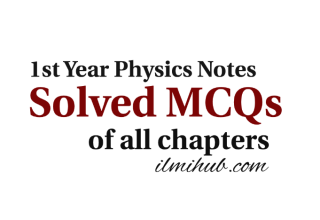In this post, I am sharing FSC 1st Year Physics Chapter 5 Short Questions with Answers Notes PDF for the students of Class 11. This is chapter number 5 from the 11th physics textbook and its name is Circular Motion. From this post, students can download the 11th Class Physics Chapter 5 Short Questions Notes in PDF format on their laptops or mobiles to read offline. These Class 11 Physics Chapter 2 Short Questions with Answers are for all the boards working under the Punjab Board like Gujranwala Board, Lahore Board, Faisalabad Board, Multan Board, Rawalpindi Board, Sargodha Board, DG Kahn Board, and Sahiwal Board. You can also download the complete FSC 1st Year Physics Notes PDF of all chapters from ilmihub.com.
11th Class Physics Chapter 5 Circular Motion Short Questions Notes PDF Download
Class 11 Physics Chapter 5 Short Questions with Answers
Explain the difference between tangential velocity and the angular velocity. If one of these is given for a wheel of known radius, how will you find the other?
Tangential Velocity:
When a body is moving on a circular path, the velocity of the body is measured at any time on the circular path called tangential velocity and obtained just by drawing a tangent at any point of the curve mathematically it is given by:
Vt = Dd/Dt
Unit:
its S.I unit is ms-1.
Angular Velocity:
The time rate of change of angular displacement of a body is called angular velocity
w = Dq/Dt
unit:
its S.I units are rads
Relation between tangential and angular velocity:
the tangential velocity v angular velocity w and the radius r of a wheel are related as:
v = w.r
Explain what is meant by centripetal force and why it must be furnished to an object to follow a circular path.
definition.
The force needed to bend the normally straight path of the particle into a circular path called the centripetal force into a circular path called the centripetal force, is always directed towards the centre of the circle.
Mathematically it is:
F = mv2/r
Significant:
A centripetal force is needed to change the direction of motion of the body continuously moving the circular path
L = mv sin q
In the case of orbital motion, the angle between the radius and tangential velocity is 900
Hence L = mv sin 900
L = mvr
To download the remaining 1st Year Physics Chapter 1 Short Questions go above and click on the red download PDF button.
Related Links:
- 1st year physics chapter 5 solved Numericals notes pdf download
- 11th class physics chapter 5 solved MCQs notes pdf download
- FSC part 1 physics chapter 5 chapter notes pdf download
- Class 11 Physics Solved Numbericals of All Chapters
- 11th Class Physics Solved MCQs of All Chapters
- 1st Year Physics Short Questions with Answers Chapter-wise





